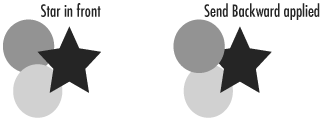Using the Arrange Commands
| Objects in InDesign are layered on top of one another in the same order they were created. (This is sometimes called the stacking order.) The first object created is behind the second, the second behind the third, and so on. Though you may not see the layering when objects are side by side, it is apparent when they overlap
Tip The layering of objects is not the same as the layers of a document. (See Chapter 11, "Layers," for more information on working with layers.) The Arrange commands allow you to move objects through the stacking order. To move up or down one level in a stack:
To move up or down the entire stack:
|
EAN: 2147483647
Pages: 309




